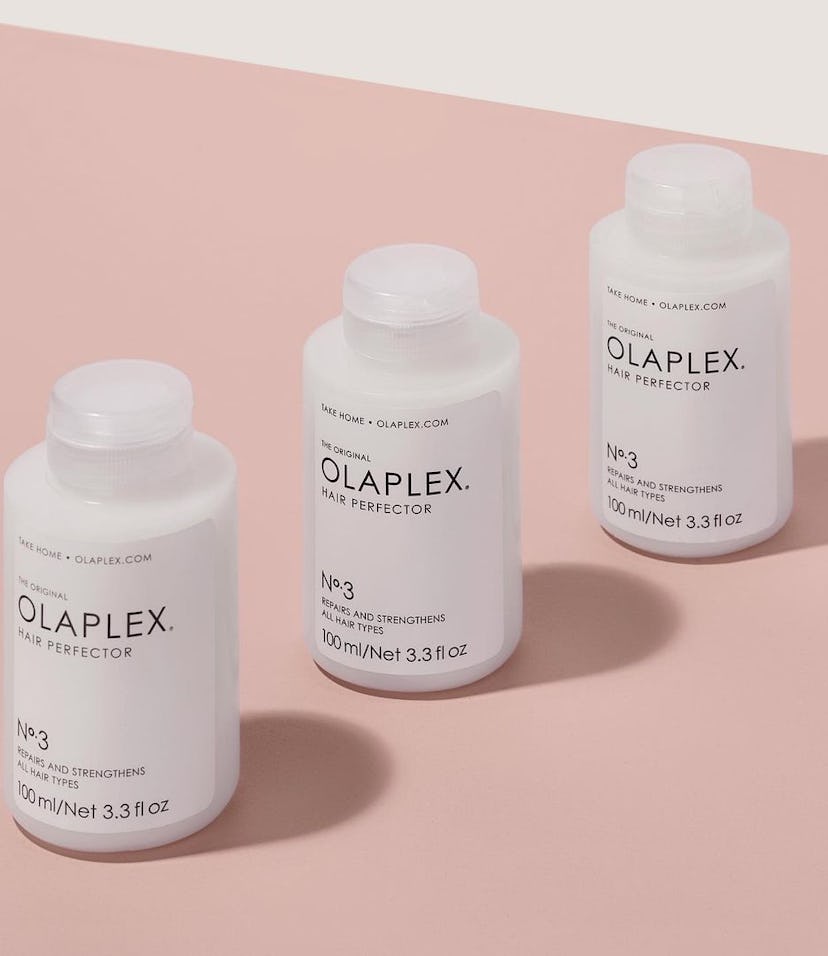(Hair)
Is Olaplex Banned In Europe? Here’s What You Need To Know About The Controversy
Don’t toss your bottles out just yet.

Since the brand made its commercial debut with a fleet of bond-building products designed to bring out hair’s healthiest, most vibrant form, Olaplex has been one of the most popular and coveted names in the hair care industry with rave reviews and accolades from users, publications, and professional hair experts alike — products like the No. 3 Hair Perfector and No.7 Bonding Oil go viral at least once a month. This week, though, the best-selling hair care brand is causing a stir in headlines and online for a very different reason.
In the final weeks of February, social media posts amassed millions of views with claims that Olaplex faces a ban from the UK and the EU over an ingredient in the formulas that is purportedly linked to infertility. Of course, even the idea that a beloved, innocuous-seeming hair care product could cause such a serious health issue put viewers in a spiral but is there even anything to freak out over? With so much misinformation flying, TZR is setting the record straight on exactly what to know about the Olaplex controversy.
Below, a complete explanation to the Olaplex ingredient ban including what it means for you and your existing products — and spoiler, you might want to hold off on tossing any bottles out just yet.
Where Did The Claim Come From?
This claim actually contains one big kernel of truth. Back in March 2020, the EU’s European Commission — a governing body that oversees legislation and lawmaking for European Union members — designated a chemical compound, 2-(4-tert-Butylbenzyl)propionaldehyde (more commonly known as butylphenyl methylpropional, or lilial), as presumptively toxic to reproduction. While the potentially toxic classification was made in 2020, it didn’t go into effect until March 1, 2022 — which is why you’re hearing about it now. The ingredient is a popular fragrance addition to cosmetics like hand creams and deodorants, and household cleaners like detergents, soaps, and air fresheners. The scientific report that catalyzed the ingredient ban dates back to 2019 (a complete dossier of which can be read online here). In the report, the experts conclude that while small amounts of the chemical are virtually harmless, compounded exposure can lead to reproductive issues, including fertility problems and damage to developing fetuses.
Outcry over the ban arose from Olaplex’s inclusion of lilial (added here as a fragrance) in perhaps its most beloved product, the Olaplex No. 3 Hair Perfector. But the brand was quick to point out that as of January 2022, no Olaplex products are formulated with lilial in the EU, UK, or anywhere else in the world to comply with the new order before it went into effect.
Will Olaplex Be Banned In Europe?
Olaplex will continue to be available in Europe, the UK, and beyond as it is no longer made with any sort of lilial. In an explanatory video posted to Olaplex’s Instagram account, Lavinia Popescu, Olaplex’s Chief Scientist and Vice President of R&D and Regulatory, explains the controversy’s roots and implications in detail. “The way Olaplex diligently used the ingredient as a fragrance, nonfunctional and not active, it should not cause infertility, miscarriages, or disruptions in fetus development,” the accompanying caption read. Lilial (or any of its other names) is no longer listed as an ingredient on Olaplex’s site or the sites of any of its vendors like Sephora. Olaplex is now 100% lilial free.
Should I Be Worried About My Olaplex Products?
Even if you’ve been using No.3 before the reformulation, there’s no need to worry. In that original lab report, the lilial in the study was fed to test subject rats rather than being applied topically, the way you use an Olaplex treatment. The first page of the paper from the Scientific Committee On Consumer Safety actually says that on an individual product basis, “butylphenyl methylpropional...can be considered safe when used as fragrance ingredient in different cosmetic leave-on and rinse-off type products” but compounded, aggregate exposure, “arising from the use of different product types together, butylphenyl methylpropional at the proposed concentrations cannot be considered as safe.” In other words, you’re fine to finish up that bottle of No.3 sitting in your bathroom.
Additionally, as the brand itself points out, the amount of lilial actually used in the product is scant, something the ban proposal papers corroborate. A data table included in the report illustrates that lilial’s concentration in hair products is typically around 0.04%, making the category among those with the lowest concentrations across the board — and Olaplex’s No.3 only used a 0.0119% concentration in its former formula.
Rest assured knowing Olaplex is safe for your body, safe for your hair, and safe to stay on shelves across the world.